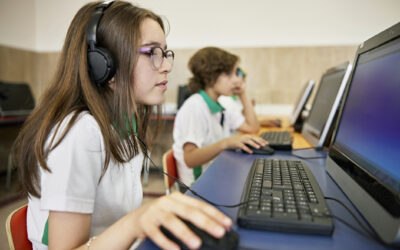After leaving teaching to pursue other interests, I started working at Learning.com and quickly realized how perfect our curriculum would be for substitute teachers. As a sub, I was always looking for activities that would provide asynchronous learning, didn’t require a lot of background knowledge or prep time, and that met state and national standards. Our curriculum at Learning.com fits the bill. Besides being grade-specific, synching with classroom LSM systems, and requiring no teacher-lead instruction, our curriculum is fun for students.
Here are some tips for acing last-minute sub plans:
Read out loud. You’d be surprised how many older students loved it when I read out loud to them. It can be a novelty as children get older to be read to, so pulling this simple trick out of your pocket at the end of a busy day or after lunch when everyone needs to relax is perfect.
Improvise and have a sense of humor. Be honest with the class, in an age-appropriate way of course. If you took the job just a few minutes before the bell rang, let them know! Kids are more understanding than adults give them credit for sometimes.
Introduce yourself to the teachers nearby. This was by far the tip that made me the most successful as a sub. Teachers are a friendly bunch of people and know first-hand how tough overseeing a classroom can be. Knowing a few of the teachers in nearby classrooms can come in handy when you have a quick question, an emergency or even just need to know where the nearest restroom is!
Last, but not least, a web-based back-up plan. Students love to get on their devices, so what better way to pass the time than with a little online lesson! There are a ton of great online tools for teachers these days, but none of them make it easier to provide grade-specific, asynchronous, standards-aligned, digital literacy curriculum to students than Learning.com. For districts that already have Learning.com, making login information available to subs is a great way to set them up for success. If you’re interested in learning more, sign up for a free trail here!
Happy Subbing!

Breanna Blanton
Product Marketer
Breanna Blanton, MBA, is Learning.com’s Associate Product Marketing Manager. She was previously a student teacher in a 2nd grade classroom and a substitute teacher for Elementary students in Washington public schools.
Further Reading
Understanding Proclamation 2024 and the TA-TEKS
Understanding Proclamation 2024 and the TA-TEKS In 2024, Texas introduced Proclamation 2024 to begin the process of adopting new instructional...
Guide to Teaching Algorithms in Computer Programming for K-12 Students
Algorithms are the heart of computer programming, providing the step-by-step instructions that computers follow to perform tasks and solve problems....
Planning Digital Literacy Assessment: A Simplified Approach
As educators know, assessments are critical to the learning process. They provide beneficial self-checks to students, informative results to...




